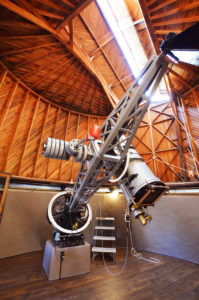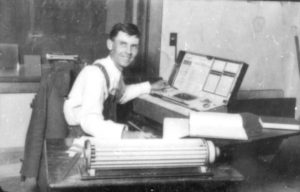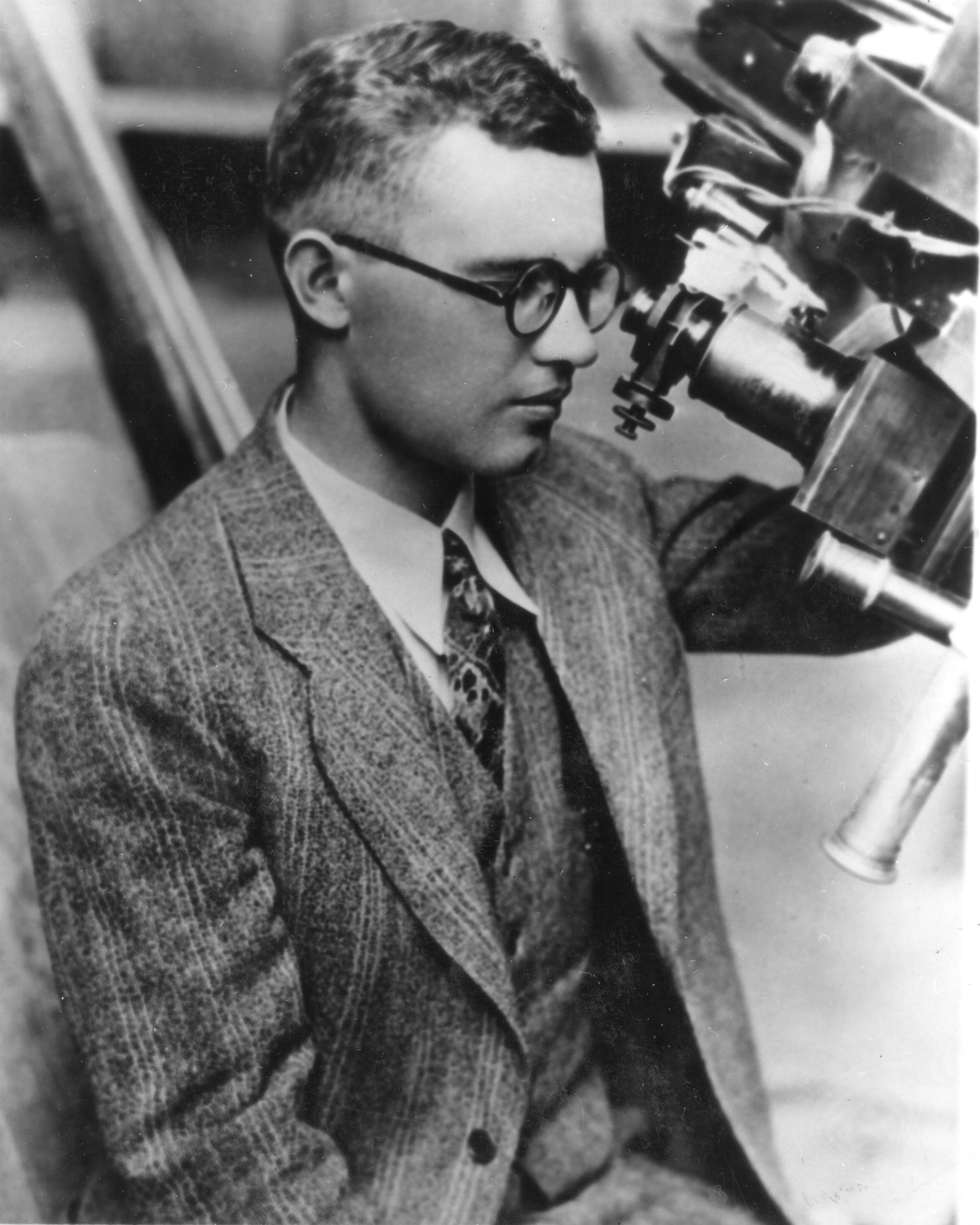Historic Pluto Astrograph Open House
Duration
Varies
When
6pm - 10pm
Schedule subject to change, check with front desk for current times.
Price
Included with General Admission
13" Lawrence Lowell Telescope
Built in 1928-1929 expressly for the purpose of completing the search for “Planet X” – the name for the hypothetical ninth planet in the solar system that Percival Lowell thought must exist – this telescope, like the Clark, is one of the most famous telescopes in the history of American astronomical research.

Known as an astrograph (or astrographic camera), the telescope has three lenses, each 13 inches (32.5 cm) in diameter. The light from a celestial object was focused onto a 14″ x 17″ (35 cm x 42.5 cm) glass photographic plate. Time exposures of about an hour were made for each image. The glass negatives were then scrutinized using the Zeiss blink comparator, which is on display in the Rotunda Museum.
Reviewing a set of glass negatives on February 18, 1930, observatory assistant Clyde Tombaugh made the first recognized sighting of the object later named Pluto.
After the discovery of Pluto, Henry Giclas used the telescope for his proper-motion survey, in which he studied the actual (not just apparent) motion of celestial objects. The telescope was later moved to the Observatory’s Anderson Mesa dark-sky site and then returned to Mars Hill in the early 1990s so our visitors could see this historic instrument first-hand.
Principal funding for the instrument and dome came from Abbott Lawrence Lowell, Percival’s younger brother and then president of Harvard University.
Since Neptune’s discovery in 1846, several astronomers had suggested the existence of yet another planet based on apparent irregularities in the orbit of Uranus. Percival Lowell began expressing his own views about this theoretical planet in his 1903 book, The Solar System, based on a series of lectures he had presented the previous year at MIT.
These first passages by Lowell were brief but marked the beginnings of what would turn into his passionate quest to find the planet he eventually referred to as “X”. He would not live to see his vision realized, but he laid the groundwork for Clyde Tombaugh’s eventual discovery in 1930.
In 1910 Lowell escalated his search after his former colleague-turned rival William Pickering published an orbit and positions of a theoretical trans-Neptunian planet. Lowell now saw his search as a race to beat Pickering and other would-be planet discoverers to the punch. From 1910 through his death in 1916, he spent significant hours on this second phase of his quest.

Lowell Observatory computer William Carrigan with calculating devices.
Lowell redoubled his mathematical efforts by incorporating the latest technology, including a Millionaire calculating machine that is still on display at Lowell Observatory. He also borrowed a nine-inch telescope from Swarthmore College’s Sproul Observatory, a vast improvement over the five-inch Brashear. With new calculations and improved equipment, Lowell estimated locations of Planet X and published his findings in the 1915 Lowell Observatory publication, Memoir on a Trans-Neptunian Planet. Unfortunately, Lowell died the following year, before he had a chance to complete a photographic search in the targeted area of the sky.
Adapted from Pluto and Lowell Observatory, Kevin Schindler and Will Grundy, 2018.
Eleven years after Lowell’s death, the final phase of Lowell Observatory’s search for Planet X commenced when Roger Lowell Putnam, Percival’s nephew, became the observatory’s sole trustee. One of his top priorities was to resume the search for Planet X and prove Lowell’s predictions.
Abbott Lawrence Lowell, Percival’s younger brother and President of Harvard University, donated $10,000 for the construction of a new telescope, a thirteen-inch photographic instrument known as an astrograph. To operate this telescope, director V.M. Slipher hired a young man from Kansas of “the self-made type,” Clyde Tombaugh.

Tombaugh arrived in Flagstaff in 1929 and soon took over the systematic search for Planet X, examining the area of sky Lowell had indicated in his Memoir on a Trans-Neptunian Planet. The 13-inch telescope was ideal for the search, and Tombaugh had the patience and attention to detail necessary for the work.
By February 1930, the 24-year-old Tombaugh had been working at Lowell Observatory for several months. To earn his monthly salary of $125 plus living quarters on the second story of the observatory’s administration building (known today as the Slipher Building), Tombaugh shoveled coal and wood into the administration building’s furnace, cleared snow off telescope domes, and presented the daily afternoon tours to visitors.
Tombaugh also led the observatory’s search for a theoretical ninth planet. On clear, moonless nights, he made photographic plates of selected areas of the night sky. These plates recorded an area of the sky about the size of a fist held at arm’s length, and with a one hour exposure, captured an average of about 300,000 star images.
During the day, Tombaugh examined pairs of these plates that captured the same portion of the sky but were taken a few days apart. His job was to use a machine called a blink comparator to look at every image from one plate to the other and see if it changed position. Most did not, but those that did represented a possible planet that changed position relative to the background stars. Later in life, Tombaugh estimated he spent 7,000 hours at the blink comparator eyepiece during his 14-year career at Lowell Observatory, an average of 500 hours per year or 63 full working days.
Tuesday, February 18, 1930, started out as a typical day for Tombaugh. He woke up at about 7:00 a.m. and drove down Mars Hill to downtown Flagstaff, where he ate breakfast and picked up the observatory’s mail.
Tombaugh returned to the observatory and by 9:00 a.m. was in the blink comparator room, settling in for another tedious day of staring through the comparator’s microscope eyepiece. The plates he examined on this day captured a portion of the constellation Gemini. He spent three hours at the comparator that morning, occasionally taking breaks from the mentally rigorous blinking. Without these breaks, his eyes would start blurring images together and his concentration would falter.
At noon, Tombaugh drove downtown for lunch and returned by 1:00 p.m. for another lengthy session of blinking. At about 4:00 p.m., he saw a faint image popping in and out of view. He had been doing this blinking business long enough to know when he had an obvious planet suspect. This definitely was one. With mounting excitement, he spent the next 45 minutes taking measurements and checking a backup set of plates taken with a 5-inch telescope mounted to the main 13-inch. Sure enough, the images were also on these plates, in the exact expected position.
Tombaugh called in astronomer Carl Lampland from across the hall, then hurried to observatory director V.M. Slipher’s office. With as much composure as he could muster, Tombaugh announced, “I have found your Planet X.”
Adapted from Pluto and Lowell Observatory, Kevin Schindler and Will Grundy, 2018.
Following Pluto’s discovery, observations continued for a while at Lowell Observatory, chiefly by Earl Slipher and Carl Lampland. But the technology of the day severely limited what they could learn. Pluto was never more than a speck on the emulsion of the glass photographic plates used for imaging the sky in that era, and it was too faint for the detailed spectroscopic studies that could have revealed its surface composition or the presence of its atmosphere. Slipher observed Pluto by eye using Lowell Observatory’s 24-inch Clark refracting telescope, in the hopes of resolving its disk and determining its diameter, but even on nights of excellent seeing he was unable to make out a disk and concluded that Pluto could be no larger than half an arcsecond across, corresponding to an upper limit of seven thousand miles on its diameter. Carl Lampland photographed Pluto through various color filters and was the first scientist to report its yellowish color, but he was unable to detect any patterns of variation in its brightness or color due to rotation. Lampland continued to record photographic plates of Pluto using the 42-inch telescope at Lowell Observatory until his death in 1951, and the resulting collection of glass plates eventually went on to play a role in navigating New Horizons to its successful encounter with Pluto
It was Lowell staff’s opportunistic pursuit of occultations that finally brought the observatory back into the business of studying Pluto, when a stellar occultation visible from Australia and New Zealand was predicted for 1988. An occultation occurs when two celestial bodies become aligned such that one of them blocks, or occults, the view of another.
The 1988 event provided a key breakthrough in Pluto studies, proving the existence of Pluto’s atmosphere and revealing its thermal structure. Astronomers predicted that this occultation would be visible from eastern Australia, New Zealand and into the Pacific Ocean. Astronomers from many institutions tried to get as close to the center of the path (center line) as practical. One group, with future Lowell astronomers Dunham and Amanda Bosh, studied the event aboard an airborne observatory. On the ground, some groups observed from well-placed, fixed observatories, while others used portable systems. Lowell’s Bob Millis and Ralph Nye set up in northeastern Australia, about thirty minutes outside of Charters Towers. Their observations, coupled with those of the other teams, revealed that the occulted star’s light dimmed gradually, which indicated an atmosphere was present.
Pluto occultation studies have continued at Lowell through the present day, involving numerous additional staff members over the years.
Meanwhile, astronomers at Lowell also used the Hubble Space Telescope to study Pluto. Several observations starting in the mid-1990s led Lowell’s Marc Buie to create the first albedo maps of Pluto, which showed the changes in reflectance of the planet’s surface.
Buie later collaborated with Will Grundy, who arrived at Lowell in 1997 and since then has carried the torch of Pluto research at Lowell, using both observational and laboratory techniques to characterize the composition of Pluto and other icy bodies.
Adapted from Pluto and Lowell Observatory, Kevin Schindler and Will Grundy, 2018.
After Clyde Tombaugh discovered Pluto with the 13” Lawrence Lowell Telescope, he continued searching for other planets until 1942, covering about 75% of the sky. The telescope was subsequently used to study asteroids and comets and search for small natural satellites of Earth and the Moon.
Later, astronomers found the telescope to be a perfect tool for one of the most important yet least known projects at Lowell, a proper motion survey of stars that compared the apparent versus actual movement of stars over time. The telescope was moved to Lowell’s Anderson Mesa dark sky site in 1970 and used for this survey until 1980.
Scientists again used the telescope for asteroid studies until it was returned to its original dome on the main Lowell campus on August 11, 1993. The telescope and its dome were put on display so visitors could experience firsthand the instrument used to discover Pluto.
More than two decades and a million visitors later, the facility was in need of refurbishment. In 2016, after 87 years of constant use, first for research and later education, the telescope’s lens assembly, mount, and other components were simply worn out.
Why bother fixing up some old telescope? The answer can be captured with two words that play off each other: legacy and pride. What’s the telescope’s legacy? First and foremost, of course, is the discovery of Pluto, an event that Time Magazine called the most important scientific discovery of the 1930s. Pluto is the first planet in our solar system discovered in the United States, and the only one discovered in the 20th century. It led to our understanding of the solar system’s “third zone”, the Kuiper belt. This makes the telescope that discovered Pluto not just a national or even international treasure, but a galactic one as well.
Who cares? Well, it turns out a lot of people take pride in Pluto’s discovery: there are the scientists who have spent much of their professional careers studying this “little planet that could”; descendants of Clyde Tombaugh, who made the family name known around the world; underdogs everywhere who are inspired by Tombaugh’s success despite his modest upbringing; Flagstaff residents who look at their city as the “home of Pluto”; Americans who likewise see Pluto as “America’s planet”; teachers who love holding up models of the solar system with nine, rather than eight planets; their eager students thirsting to learn about the wonders of space; historians who point out Pluto’s discovery as a bright light in an otherwise very dark period that saw the ravages of the depression capture most headlines; writers who are entranced by the magic of a world recently unveiled by NASA’s New Horizons mission; and everyday people who wear shirts with messages such as “When I was your age Pluto was a Planet”, “Pluto demands a recount”, “It’s OK Pluto, I’m not a planet either”, “Pluto: Never Forget”, “RIP Pluto: 1930 – 2006”, and a few downright foul ones that our censors won’t let us share.
The refurbishment included testing and fixing the telescope’s drive motor and other electronic components; restoring plate holders and control knobs; cleaning plate holders, control knobs, optics, and other parts; and removing, cleaning, and reinstalling the telescope itself. The restoration team was the same one that fixed up Lowell’s magnificent 24” Clark Refractor. It consisted of five Lowell staff members with expertise in telescope maintenance and restoration, instrumentation, machining, and woodworking. The work started in 2017 and was finished the following year.
The face of Pluto changed forever with New Horizons’ flyby in 2015. It would now grow from the dot that Clyde Tombaugh saw when he discovered the Planet 85 years earlier, to a world with active geology and awe-inspiring surface features.
Many members of the New Horizons Science had Lowell Observatory ties, particularly Will Grundy, who headed the mission’s surface composition team.
The first data set to be transmitted back after closest approach was colloquially referred to as the New York Times dataset. It contained a few choice observations from each of New Horizons’ scientific instruments, highly compressed in order to get them down as quickly as possible. The compression produced strange-looking jpeg artifacts, but the data enabled the science team to release a spectacular series of images and new discoveries over the days following the encounter, culminating in another press conference on July 17. Images from the NYT dataset lived up to the ambition of their nickname, appearing above the fold on the front page of the New York Times on July 16.
After the encounter phase, the science team dispersed and the pace relaxed, but only a little. The calendar was dictated by the slow communication rate from the edge of the solar system. Owing to the low power of the spacecraft’s radio transmission (24 watts maximum) and small size of its antenna (seven feet), the highest possible data rate was only about 2,000 bits (2 kbit) per second. This is extremely slow, as anyone old enough to remember connecting to the Internet over a telephone line using a modem will recall. Typical modem speeds were much higher at 24, 36 or 56 kbit/sec. At this rate, which Lowell astronomer Gerard van Belle characterized as a “tweet per second,” it took about a year and a half for New Horizons to transmit all of the encounter data home, though of course the science team prioritized the order so that the most important observations were sent first. There was plenty of work to be done as the encounter data trickled in. For an entire year, the team put out weekly image and news releases. The process to develop these communications was modeled on the daily cycle of meetings during the encounter phase but now conducted via telecons instead of in person and spread over the course of a week, instead of repeating every day. The team was also busy writing scientific papers, including five that appeared in a special issue of Science in late 2016 and dozens more that came out in a special issue of Icarus in early 2017. There were also presentations to create and present at a series of scientific meetings, colloquium talks whenever anyone visited another institution, plus countless public talks. Considerable data processing work was needed, too, since all of the data had to be delivered to the public Planetary Data System (PDS) archive, along with higher-level products such as maps and image mosaics. Many of the papers and data products had delivery deadlines, meaning that the quality of the work had to be tailored to the available time rather than doing the best that can be done and taking as long as that requires, a very different mode from how individual scientists usually operate. Thus, the early papers were quickly superseded by subsequent ones, and those were, in turn, eclipsed by later papers.
Overall, the New Horizons Pluto encounter was a spectacular success, despite a few glitches. The last time that a previously unexplored planet had received its first up-close visit was the Voyager 2 encounter with Neptune in 1989. This was even more novel, since Pluto was the first of its class of small icy planets to be explored. Through New Horizons, a new generation across the globe experienced the thrill of this kind of discovery for the first time.
Here are of some of New Horizons’ most remarkable Pluto findings, according to Principal Investigator and Lowell Advisory Board member Alan Stern:
Adapted from Pluto and Lowell Observatory, Kevin Schindler and Will Grundy, 2018.